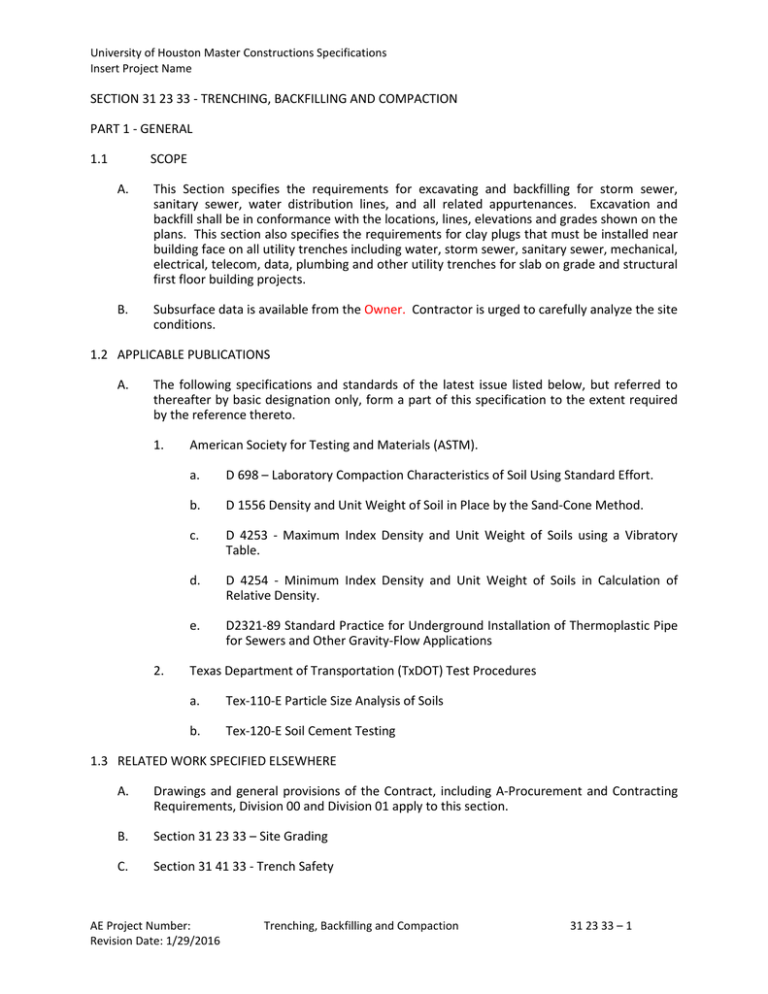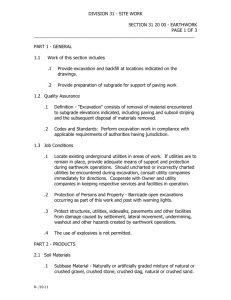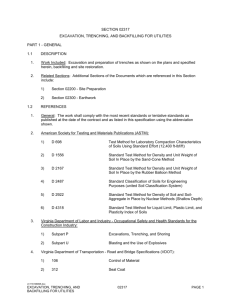SECTION 31 23 33 - TRENCHING, BACKFILLING AND COMPACTION 1.1
advertisement

University of Houston Master Constructions Specifications Insert Project Name SECTION 31 23 33 - TRENCHING, BACKFILLING AND COMPACTION PART 1 - GENERAL 1.1 SCOPE A. This Section specifies the requirements for excavating and backfilling for storm sewer, sanitary sewer, water distribution lines, and all related appurtenances. Excavation and backfill shall be in conformance with the locations, lines, elevations and grades shown on the plans. This section also specifies the requirements for clay plugs that must be installed near building face on all utility trenches including water, storm sewer, sanitary sewer, mechanical, electrical, telecom, data, plumbing and other utility trenches for slab on grade and structural first floor building projects. B. Subsurface data is available from the Owner. Contractor is urged to carefully analyze the site conditions. 1.2 APPLICABLE PUBLICATIONS A. The following specifications and standards of the latest issue listed below, but referred to thereafter by basic designation only, form a part of this specification to the extent required by the reference thereto. 1. 2. American Society for Testing and Materials (ASTM). a. D 698 – Laboratory Compaction Characteristics of Soil Using Standard Effort. b. D 1556 Density and Unit Weight of Soil in Place by the Sand-Cone Method. c. D 4253 - Maximum Index Density and Unit Weight of Soils using a Vibratory Table. d. D 4254 - Minimum Index Density and Unit Weight of Soils in Calculation of Relative Density. e. D2321-89 Standard Practice for Underground Installation of Thermoplastic Pipe for Sewers and Other Gravity-Flow Applications Texas Department of Transportation (TxDOT) Test Procedures a. Tex-110-E Particle Size Analysis of Soils b. Tex-120-E Soil Cement Testing 1.3 RELATED WORK SPECIFIED ELSEWHERE A. Drawings and general provisions of the Contract, including A-Procurement and Contracting Requirements, Division 00 and Division 01 apply to this section. B. Section 31 23 33 – Site Grading C. Section 31 41 33 - Trench Safety AE Project Number: Revision Date: 1/29/2016 Trenching, Backfilling and Compaction 31 23 33 – 1 University of Houston Master Constructions Specifications Insert Project Name D. Section 33 10 00 – Water Distribution System E. Section 33 30 00 – Sanitary Sewer F. Section 33 34 00 – Sanitary Force Main G. Section 33 40 00 - Drainage 1.4 SUBMITTALS A. Material Test Reports: From a qualified testing agency indicating and interpreting test results for compliance of the following with requirements indicated: 1. B. Classification according to ASTM D 2487 of each [on-site] [and] [or] [borrow] soil material proposed for backfill Pre-excavation Photographs or other digitally recorded media: Show existing conditions of adjoining construction and site improvements, including finish surfaces that might be misconstrued as damage caused by earthwork operations. Submit before excavation begins. 1.5 PROJECT CONDITIONS A. Existing Utilities: Do not interrupt utilities serving facilities occupied by Owner or others unless permitted in writing by Owner and then only after arranging to provide temporary utility services according to requirements indicated 1. Follow the University of Houston’s Plant Operations Planned and Emergency Utility Outage Policy. 2. Utility Locator Service: Notify Lonestar Notification Center at 713-732-0365 for area where Project is located before excavating. B. Demolish and completely remove from site existing underground utilities indicated to be removed. Coordinate with utility companies to shut off services if lines are active. C. Utilities have been located from surveys and available existing records. Not all utilities may be shown on the Drawings. Locate all utilities prior to beginning any construction activities. D. Where utilities require adjustment or relocation to construct the Work, and those utilities are shown on the Drawings, relocation or adjustment is a part of the Work and shall be completed at no additional expense to the Owner. E. Where utilities require adjustment or relocation to construct the Work, and those utilities are not shown on the Drawings, notify Architect before proceeding. Relocate or adjust utility as directed. Utility relocation and/or adjustment will be paid for according to the Contract provisions for changes in Work. F. If utility is damaged by Contractor, notify utility owner and Architect immediately. Repair or replacement of utilities damaged by Contractor, whether utilities are shown on the drawings or not shown on the drawings, shall be Contractor's expense. 1.6 PERMITS AE Project Number: Revision Date: 1/29/2016 Trenching, Backfilling and Compaction 31 23 33 – 2 University of Houston Master Constructions Specifications Insert Project Name A. Prior to commencement of work, the Contractor shall be responsible for obtaining, at the contractors own expense, all construction permits necessary to complete the project according to the plans and specifications. 1.7 DEFINITIONS A. Excavation consists of the removal of material encountered to subgrade elevations and the reuse or disposal of materials removed. B. Subgrade: The uppermost surface of an excavation, including excavation for trenches, or the top surface of a fill or backfill immediately below base course, pavement, or topsoil materials. C. Borrow: Soil material obtained off-site when sufficient approved soil material is not available from excavations. D. Base Course: The layer placed between the subgrade and surface pavement in a paving system. E. Unauthorized excavation consists of removing materials beyond indicated subgrade elevations or dimensions without direction by the Owner’s rep. Unauthorized excavation, as well as remedial work directed by the Owner’s Rep shall be at the Contractor's expense. F. Structures: Buildings, footings, foundations, retaining walls, slabs, tanks, curbs, mechanical and electrical appurtenances, or other man-made stationary features constructed above or below ground surface. G. Utilities include underground pipes, conduits, ducts, and cables, as well as underground services within building lines. H. Unforeseen Excavation: Excavation of material, regardless of its character or nature, below the subgrade elevation required to construct the work as indicated on the drawings or specified herein. I. Bedding Material: excavations. Granular material utilized to bed piped utilities placed in trench 1.8 QUALITY ASSURANCE A. Pre-Excavation Conference: Conduct conference at Project site to comply with requirements in Division 01. B. Codes and Standards: Perform earthwork complying with requirements of authorities having jurisdiction. C. Testing and Inspection Service: Owner will employ a qualified independent geotechnical engineering testing agency to classify proposed on-site and borrow soil materials to verify that soils comply with specified requirements and to perform required field and laboratory testing. PART 2 - PRODUCTS AE Project Number: Revision Date: 1/29/2016 Trenching, Backfilling and Compaction 31 23 33 – 3 University of Houston Master Constructions Specifications Insert Project Name 2.1 EARTH BACKFILL A. Earth backfill shall be native soils free of debris, trash, rocks over 2 inches in diameter and other objectionable material. 2.2 CEMENT STABILIZED SAND BACKFILL A. Cement stabilized sand material shall contain clean bank sand meeting TxDOT Test Method TEX-110-E, water and a minimum of 7% hydraulic cement based on the dry weight of the aggregate meeting TxDOT Test Method Tex-120-E. 2.3 SAND BACKFILL A. Clean bank sand meeting TxDOT Test Method TEX-110-E. 2.4 WATER A. Water used for mixing or curing shall be reasonably clean and free of oil, salt, acid, alkali, sugar, vegetable matter or other substances injurious to the finished product. B. Water sources other than the local municipal domestic water supply must be approved by the Owner. C. If onsite reclaimed water sources are used, tanks and apprentices must be clearly marked with the words “non-potable” water. PART 3 - EXECUTION 3.1 PREPARATION A. Protect structures, utilities, sidewalks, pavements, and other facilities from damage caused by settlement, lateral movement, undermining, washout, and other hazards created by earthwork operations. B. Provide erosion-control measures to prevent erosion or displacement of soils and discharge of soil-bearing water runoff or airborne dust to adjacent properties and walkways. 3.2 EXCAVATION A. General: 1. All utility trenches shall be constructed in conformance with OSHA trench safety standards. 2. Sheeting and shoring shall be accomplished to the extent necessary to maintain the sides of the trench in a vertical position throughout the construction period for trenches five (5) feet in depth or deeper. Where approved, trench sides may be laid back in lieu of shoring to meet OSHA safety standards. 3. Utilities shall not be constructed or laid in a trench in the presence of water. All water shall be removed from the trench sufficiently prior to the line placing operation to insure a dry, firm bed on which to place the utility line. AE Project Number: Revision Date: 1/29/2016 Trenching, Backfilling and Compaction 31 23 33 – 4 University of Houston Master Constructions Specifications Insert Project Name 4. B. C. a. If excavated materials intended for fill and backfill include unsatisfactory soil materials and rock, replace with satisfactory soil materials. b. Remedial work due to over-excavation including provision of suitable and stable backfill meeting the degree of compaction required shall be at the Contractor’s expense. 5. Borrow Material: If excavated materials of a suitable nature are not of sufficient quantity to complete the work, provide borrow material in sufficient quantity to complete the work at no additional cost to the Owner. 6. Disposing of Excavated Material: Dispose of excess satisfactory soil material and all unsatisfactory soil material and rock obtained from excavations in accordance with the provisions of this Section. 7. Where utilities are in fill, compact fill material to 95% standard proctor maximum dry density at least 12” above the top of the proposed utility prior to excavation of trench. 8. Where indicated widths of utility trenches are exceeded, provide stronger pipe, or special installation procedures, as required by Owner’s Rep. Unauthorized excavation, as well as remedial work directed by the Owner’s Rep, shall be at the Contractor’s expense. Sewer Trenches: 1. For pipe sizes less than 42" in diameter, the minimum trench width shall be outside diameter of pipe plus 18 inches. 2. For pipe sizes 42" in diameter and larger the minimum trench width shall be outside diameter of pipe plus 24 inches. 3. Trenches shall be excavated to a depth at least 6" below the barrel of pipe, and then the pipe bedding shall be placed as shown on the appropriate details contained with the plans and as described in paragraph 3.3 A. of this section. Appurtenances 1. D. Unclassified Excavation: Excavation is unclassified and includes excavation to subgrade elevations regardless of the character of surface and subsurface conditions encountered, including rock, soil materials, and obstructions. Excavation for manholes, tie-in to existing facilities and similar structures shall be sufficient to leave at least 12" clear between the outer surfaces and the embankment or sheeting that may be used to hold and protect the banks. Any over depth excavation below such appurtenances shall be refilled with cement stabilized sand, as directed, at no additional cost to Owner. Water line Trenches: 1. Water lines must be a minimum of four feet in depth from the top of proposed grade to the top of pipe, unless otherwise shown on the plans. AE Project Number: Revision Date: 1/29/2016 Trenching, Backfilling and Compaction 31 23 33 – 5 University of Houston Master Constructions Specifications Insert Project Name 2. Trench width for water lines shall be a minimum of the outside pipe diameter plus 18 inches. 3. Trenches shall be excavated to a depth of at least 6 inches below the barrel of pipe, and then the pipe bedding shall be placed as shown on the details within the plans and as described in paragraph 3.3 B. of this section. 3.3 PIPE BEDDING AND BACKFILL A. B. Storm and sanitary sewer trenches: 1. Pipe shall be bedded in trench in accordance with the details shown on the plans. When pipe has greater than twelve (12) feet of cover, use Class A bedding and backfill. 2. Cement stabilized sand shall be per Part 2.2.A of this specification, mixed in a mill type mixer. When the details call for cement stabilized sand bedding, the material shall extend from a point 6" below the bottom of the pipe to the level of the spring line. This material cannot be used after is loses its moisture content. 3. The cement stabilized sand shall be thoroughly rodded after being placed in trench. 4. Bedding, sewer pipe and initial backfill over the top of pipe must be placed in a single day's operation for any given portion of pipe. Initial backfill shall be placed to one foot above the top of pipe for earth backfill and 6 inches over the top of pipe for cement stabilized sand backfill. 5. Remainder of trench backfill shall be placed the next day or later in 8" lifts, after pipe is laid in conformance with these specifications and the details on the plans. 6. Backfill shall be placed in uniform layers not to exceed 8" loose depth, and compacted to a minimum of 95 percent of Standard Maximum Density (ASTM D 698) at the proper moisture content specified in the Geotechnical report for this project. 7. Backfill, under pavement and to one foot from outer edge, shall be cement stabilized sand of the type and method described under paragraph 3.3 A.1 through 5, above, up to one foot below subgrade elevation. Remainder of backfill to subgrade to be as specified in paragraph 3.3 A.5. above and stabilized where required. Water line Trenches 1. Pipe bedding shall consist of 6 inches of clean sand placed before the pipe is laid. 2. After laying pipe and insuring that the pipe is properly placed and supported by the sand bedding, clean sand backfill shall be placed to 6 inches above the top of pipe. The sand backfill shall be thoroughly rodded and tamped for compaction. 3. For water lines beneath pavement and to one foot horizontally from the outer edge of pavement, the remainder of the trench backfill shall be clean sand placed up to the top of subgrade, thoroughly rodded and tamped. 4. For water lines not beneath pavement or within one foot horizontally from the outer edge of pavement, the remainder of the trench backfill shall be earth fill paced in uniform layers not to exceed 8" loose depth, each lift to be compacted to a minimum AE Project Number: Revision Date: 1/29/2016 Trenching, Backfilling and Compaction 31 23 33 – 6 University of Houston Master Constructions Specifications Insert Project Name of 95 percent of Standard Density (ASTM D698) at the proper moisture content specified in the Geotechnical report for this project. All earth backfill to be placed the next day or later after the pipe is laid. C. Bentonite Clay Plug for All Utility Trenches (water, storm, sanitary, mechanical, electrical, telecom, plumping, etc.) 1. All trenches must have a bentonite granular clay plug installed to reduce the transmission of ground water under slab on grade buildings and structural first floor buildings. a. The plug must be installed at a distance of one foot beyond the face of the building foundation and be a minimum of one-foot wide. b. The plug must extend 6” beneath utility trench into undisturbed soil. This portion of the clay plug must be installed prior to the installation of the utility pipe. c. The plug must extend across the entire trench width and extend 6” into undisturbed soil beyond the trench width. Install bentonite clay plug and the utility pipe at the same time. d. The plug must extend to within 12” of finished grade. A clay plug cap consisting of material with a plasticity index greater than 15 and a liquid limit in excess of 30 shall be placed on top of the bentonite granular clay plug. This clay plug cap shall fill the remaining 12” up to finished grade and be placed up to the edge of the building. 3.4 STORAGE OF SOIL MATERIALS A. Stockpile borrow materials and satisfactory excavated soil materials. Stockpile soil materials without intermixing. Place, grade, and shape stockpiles to drain surface water. Cover to prevent windblown dust. 1. Stockpile soil materials away from edge of excavations. Do not store within drip line of remaining trees. 3.5 FIELD QUALITY CONTROL A. General: Testing shall be the responsibility of Owner and costs of initial testing will be paid by Owner. Cost of subsequent testing necessary due to non-compliance with Specifications shall be paid by Contractor. B. Density Test: 1. Density tests shall be performed by representatives of Owner’s Testing Agency. 2. Frequency and scope of testing shall be established by Geotechnical Engineer, and as required by local jurisdictional authority. AE Project Number: Revision Date: 1/29/2016 Trenching, Backfilling and Compaction 31 23 33 – 7 University of Houston Master Constructions Specifications Insert Project Name If Geotechnical Engineer has not established a frequency of testing in the Geotechnical Report, testing shall be at every 100 linear foot of trench at a minimum of one per lift and a minimum of one per day. 3. Tests shall be performed in accordance with the referenced Standards. 4. Laboratory tests for moisture-density relations shall be determined in accordance with ASTM D 1557. A minimum of one test shall be performed for each major soils type. In addition, sufficient number of retests or check points shall be performed to evaluate accuracy of maximum density values being used. 5. Field in-place density shall be determined in accordance with ASTM Test Methods D 1556 or D 2922, and the moisture-density relations shall be determined in accordance with ASTM Test Method D 1557. 6. Reopen improperly compacted trenches to depth directed, then refill and compact to the specified density at no additional cost to Owner END OF SECTION AE Project Number: Revision Date: 1/29/2016 Trenching, Backfilling and Compaction 31 23 33 – 8



